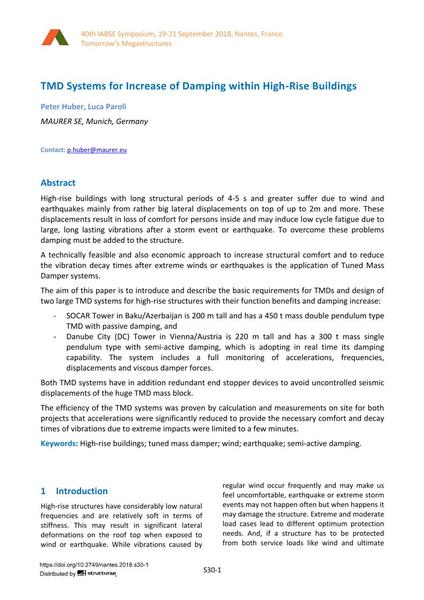TMD Systems for Increase of Damping within High-Rise Buildings

|
|
|||||||||||
Bibliographic Details
| Author(s): |
Peter Huber
(MAURER SE, Munich, Germany)
Luca Paroli (MAURER SE, Munich, Germany) |
||||
|---|---|---|---|---|---|
| Medium: | conference paper | ||||
| Language(s): | English | ||||
| Conference: | IABSE Symposium: Tomorrow’s Megastructures, Nantes, France, 19-21 September 2018 | ||||
| Published in: | IABSE Symposium Nantes 2018 | ||||
|
|||||
| Page(s): | S30-1 | ||||
| Total no. of pages: | 8 | ||||
| DOI: | 10.2749/nantes.2018.s30-1 | ||||
| Abstract: |
High-rise buildings with long structural periods of 4-5 s and greater suffer due to wind and earthquakes mainly from rather big lateral displacements on top of up to 2m and more. These displacements result in loss of comfort for persons inside and may induce low cycle fatigue due to large, long lasting vibrations after a storm event or earthquake. To overcome these problems damping must be added to the structure. A technically feasible and also economic approach to increase structural comfort and to reduce the vibration decay times after extreme winds or earthquakes is the application of Tuned Mass Damper systems. The aim of this paper is to introduce and describe the basic requirements for TMDs and design of two large TMD systems for high-rise structures with their function benefits and damping increase:
Both TMD systems have in addition redundant end stopper devices to avoid uncontrolled seismic displacements of the huge TMD mass block. The efficiency of the TMD systems was proven by calculation and measurements on site for both projects that accelerations were significantly reduced to provide the necessary comfort and decay times of vibrations due to extreme impacts were limited to a few minutes. |
||||
| Keywords: |
wind earthquake high-rise buildings tuned mass damper semi-active damping
|
||||
